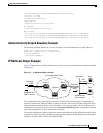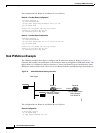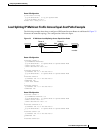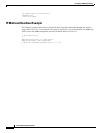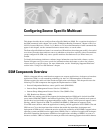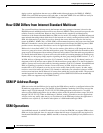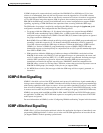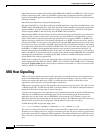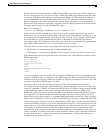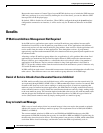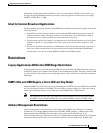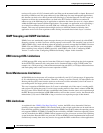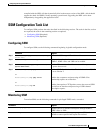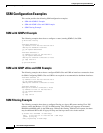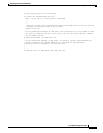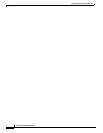
Configuring Source Specific Multicast
URD Host Signalling
IPC-463
Cisco IOS IP Configuration Guide
When the browser of a host encounters a URD intercept URL, it will try to open a TCP connection to
the web server on port 465. If the last hop router is enabled for URD on the interface where the router
receives the TCP packets from the host, it will intercept all packets for TCP connections destined to
port 465 independent of the actual destination address of the TCP connection (independent of the
address of the web server). Once intercepted, the last hop router will “speak” a very simple subset of
HTTP on this TCP connection, emulating a web server. The only HTTP request that the last hop router
will understand and reply to is the following GET request:
GET argument HTTP/1.0
argument = /path?group=group&source=source1&...source=sourceN&
When it receives a GET command, the router tries to parse the argument according to this syntax to
derive one or more (S, G) channel memberships. The path string of the argument is anything up to, but
not including, the first question mark, and is ignored. The group and source1 through sourceN strings
are the IP addresses or fully qualified domain names of the channels for which this argument is a
subscription request. If the argument matches the syntax shown, the router interprets the argument to be
subscriptions for the channels (source1, group) through (sourceN, group).
The router will accept the channel subscriptions if the following conditions are met:
• The IP address of the multicast group is within the SSM range.
• The IP address of the host that originated the TCP connection is directly connected to the router.
If the channel subscription is accepted, the router will respond to the TCP connection with the following
HTML page format:
HTTP/1.1 200 OK
Server:cisco IOS
Content-Type:text/html
<html>
<body>
Retrieved URL string successfully
</body>
</html>
If an error condition occurs, the <body> part of the returned HTML page will carry an appropriate error
message. The HTML page is a by-product of the URD mechanism. This returned text may, depending
on how the web pages carrying a URD intercept URL are designed, be displayed to the user or be sized
so that the actual returned HTML page is invisible.
The primary effect of the URD mechanism is that the router will remember received channel
subscriptions and will match them against IGMP group membership reports received by the host. The
router will “remember” a URD (S, G) channel subscription for up to 3 minutes without a matching IGMP
group membership report. As soon as the router sees that it has received both an IGMP group
membership report for a multicast group G and a URD (S, G) channel subscription for the same group G,
it will join the (S, G) channel through PIM-SSM. The router will then continue to join to the (S, G)
channel based only on the presence of a continuing IGMP membership from the host. Thus, one initial
URD channel subscription is all that is needed to be added through a web page to enable SSM with URD.
If the last hop router from the receiver host is not enabled for URD, then it will not intercept the HTTP
connection toward the web server on port 465. This situation will result in a TCP connection to port 465
on the web server. If no further provisions on the web server are taken, then the user may see a notice
(for example, “Connection refused”) in the area of the web page reserved for displaying the URD
intercept URL (if the web page was designed to show this output). It is also possible to let the web server
“listen” to requests on port 465 and install a Common Gateway Interface (CGI) script that would allow
the web server to know if a channel subscription failed (for example, to subsequently return more
complex error descriptions to the user).



